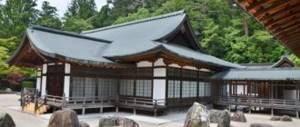Japanese cuisine Japanese cuisine is very simple, but at the same time incredibly diverse.
There is no such diversity in any national cuisine. Japanese cuisine is preferred by lovers of fish and meat, as well as supporters of a healthy and vegetarian diet. The Japanese eat foods at the time of year when they are especially tasty and healthy. In the Land of the Rising Sun, this culinary feature is especially revered, and they firmly believe that bamboo shoots are good in the spring, and lotus roots - in the spring and autumn, stewed eel pieces and fried trout - best restore strength in the summer.
Japanese dishes are gaining more and more popularity every year . Why do people who adhere to a healthy lifestyle choose this eastern way of eating? The answer is simple! According to statistics, Japan is a country of long-livers. This is the best proof that the foods eaten there are ideal for the human body. So what is the secret of Japanese longevity? The secret is in the national cuisine.
Many are accustomed to thinking that Japanese gastronomy consists of traditional sushi, rolls, rice, soy. In fact, there are a great variety of delicacies and unusual dishes in Japanese cuisine. Reducing everything to just sushi and rolls is wrong and even insulting!
Japanese culinary technology
The Japanese process their food minimally, which cannot be said about neighboring countries, where the choice of sauce for a dish plays the most important role. For example, in China, the sauce and method of preparation changes the same dish beyond recognition.
The Japanese attach great importance to the appearance and high quality of their dishes. Everything in a dish should be harmonious: taste, appearance, and benefits.
Local chefs always try to preserve the original taste and appearance of products. For example, for the Japanese, fish is wonderful on its own; it only needs a little salt and fresh air. This is the main principle and difference between Japanese cuisine and the culinary traditions of all other countries.
Sauces rating
Properly selected seasoning is half the success , because it can reveal the dish and emphasize its rich taste.
Curry seasoning is quite universal in this regard; it suits almost any dish. The main secret to a perfect dish is to choose the right sauce.
How to choose the right sauce, what new products you can see on the market, how to understand the variety of sauces - we’ll look at this in this article. The most popular sauces were compiled into a kind of rating, based on reviews from real consumers.
- In first place is S&B Foods “Golden Curry” extra spicy - this seasoning for lovers of spicy dishes does not contain GMOs. The seasoning is made in Japan. Price – 445 rub.
- Rioba – sweet-spicy flavor and rich combination of seasonings go well with meat dishes. Sold in packs (18 pieces), cost – 96 rubles.
- AROY-D is a green curry paste with an unusual oriental aroma, best suited for athletes and vegetarians. Sold in a plastic jar. Cost – 300 rub.
- Spilva Curry with pineapple - the presence of pineapple gives it an unusual and original taste. The thick consistency goes well with rice and chicken dishes. Average cost: 234 rub.
- Kuhne Indian curry will add a spicy note to the dish and goes especially well with chicken. Cost – 125 rubles.
- Remia Curry is a not too spicy condiment from the Netherlands that has the consistency of a paste. Price – 210 rub.
- “VkusVill” is a sauce based on applesauce, not spicy. The composition is natural, without flavor enhancers. Cost – 75 rubles.
- Chef Curry - made in Russia. Portion packaging for single use (packaging – 25 g) makes the sauce even more attractive. Price: 9.9 rub.
- Heinz Curry is a mild sauce with a creamy consistency. Manufacturer: Netherlands. Price: 90 rub.
- Spicy curry from the “Bamboo Stalk” series is a mild sauce made in Russia that goes well with fish. A light spicy aroma will add piquancy to the dish. A glass bottle allows you to store the sauce for a long time in the refrigerator. Average price: 125 rub.
- Kohinoor Madras Curry Cook-in Sauce is a hot sauce, unusually spicy and fiery, with ginger in its composition. Cost: 269 rub.
- Mr. Djemius ZERO - non-spicy pasta with natural ingredients has a creamy consistency - an excellent addition to any dish. Price: 179 rub.
- Hachi Shokushin – sauce in portioned packaging (made in Japan) will make any dish juicy and unusually aromatic. Does not contain GMOs. Cost: 189 rub.
- Thai Food King - green curry paste with a spicy taste is well suited as a marinade for any fish. Cost: 237 rub.
- BioMeals Dieta Sauce , Indian curry - has a paste-like consistency. Low in calories, does not contain sugar or fat. Cost: 450 rub.
Rice is the boss of everything!
For the Japanese, “rice” is the same as “bread” for a Russian. This grain is the main ingredient of Japanese cuisine and the basis of Japanese nutrition. On average, a Japanese eats about 100 kilograms of rice per year.
If we are used to cooking fluffy rice as a side dish, then in Japan they prefer sticky and heavily boiled rice , because this is the kind that is convenient to eat with chopsticks. The Japanese do not salt rice or add oil to it. They also believe that rice, like a person, has a soul, so it must be treated with respect and reverence. The Japanese's everyday dish is rice with egg omelet, soy sauce and fish.
The world famous alcoholic drink sake, Japanese beer, and many different delicious desserts are made from rice.
Rice is the basis of Japanese cuisine
Ingredients:
- Rice - 1.5 cups
- Corn - 100 grams (canned or frozen)
- Peas - 100 grams (canned or frozen)
- Bell pepper - 1-2 pieces (preferably different colors)
- Carrots - 1-2 pieces
- Broccoli – 100 grams (fresh or frozen)
- Cauliflower – 100 grams (fresh or frozen)
- Vegetable oil - 4-5 tbsp. spoons
- Soy sauce - 2-3 tbsp. spoons (to taste)
- Salt - 0.5 teaspoons (to taste)
Number of servings: 4-5
Every day is a fish day!
Dishes from fish, sea animals and various shellfish in Japanese cuisine are in second place in popularity after rice. As a rule, fish undergoes minimal heat treatment when cooking. And the popular Japanese dish sashimi is generally prepared from raw, lightly marinated fish. Slices of sashimi are served on a flat plate with a side dish of fresh vegetables, such as white daikon radish, which is eaten as often as rice in the Land of the Rising Sun.
Sashimi
Regular rice products
Rice wine (Nihonshu or Sake)
Rice wine, commonly known as nihonshu or sake (sake is also used as a general term for alcohol), is an alcoholic beverage made by fermenting rice. Sake comes in several varieties and can be served hot or cold. Traditionally, it is not drunk with rice dishes, as it is considered rice. Mirin is a sweet rice wine that is widely used in cooking.
Rice Vinegar
Vinegar can also be obtained from rice and is used in dressings, cucumber pickles, marinades and for cooking sushi rice. Most Japanese rice vinegars are light in color and flavor and only slightly sour. Dark vinegars are also produced and consumed as a medicinal drink.
Rice flour
Rice flour, made from ground white or glutinous rice, is used to make various Japanese sweets and rice crackers (senbei), as a thickener in cooking, or as a substitute for wheat flour in making bread. Rice flour does not contain gluten.
Rice bran (Nuka)
Rice bran, or nuka, is the hard outer husk of rice grains that is removed when brown rice is polished to produce white rice. Rice bran has a high nutritional value and is used in Japanese cooking in a variety of ways, most commonly to make brine (nukazuke).
Sushi - there is no better food!
In recent years, sushi has competed with Italian pizza and the American burger. Japanese restaurants are opening with enviable regularity all over the world. Only, unlike its competitors, sushi is the standard healthy food! They are prepared from cooked rice and raw seafood. There are two main types: the first is the sushi itself, the second type is the rolls, which are prepared in a fundamentally different way. Rice and seafood are laid out in layers on a sheet of seaweed, then rolled into a thin roll. The roll is cut crosswise into small pieces with a sharp knife. The rolls are served on a flat plate or wooden stand, with wasabi horseradish, soy sauce and pickled ginger.
Sushi
A real delicacy - poisonous fish!
fugu fish dish is an unforgivable mistake. Locals love this fish very much, despite the fact that the dish can be deadly. Every year the Japanese eat over 2 thousand tons of poisonous fugu. A person just needs to touch its insides with his hand to receive a lethal dose of poison. If there is fugu on the restaurant menu, this indicates the presence of a high-class chef: strict requirements are put forward for the master who cooks fugu - he must study for two years at a special school, where they reveal the secrets and features of preparing such a dangerous fish. After school, chefs pass a difficult state exam. This dish is prepared as follows: the cook separates the fins with quick blows of a sharp and thin knife, after which he carefully removes the poisonous parts and removes the skin. The fillet is cut very thin, like a sheet of paper. This dish is not only tasty, but also very beautiful, since the chef creates real artistic landscapes on a plate of fish pieces. It is considered the highest skill when the chef leaves an exact dose of poison in the fish so that restaurant guests have a barely noticeable feeling of drug intoxication.
Puffer fish
Rice fields and rice attractions
Rice fields are a common sight in rural Japan and an image of nostalgia for many people. The fields begin as flooded fields in early summer and transform into seas of green and gold waves as the rice grows and matures throughout the season. The rice crop is then usually harvested in the fall, although in some southern regions more than one crop may be grown per year.
Sankyo rice warehouses. Sakata city.
Some places known for particularly beautiful rice cake scenery include the Noto Peninsula in Ishikawa Prefecture, Shodoshima Island in Kagawa Prefecture, and the Echigo Tsumari area in Niigata Prefecture.
Surrounded by the fertile Shonai Plain, the city of Sakata in Yamagata Prefecture has been a center of rice trading for centuries. One of the city's tourist attractions is a series of historic rice warehouses, one of which has been opened to the public as a local rice museum.
Views: 2,605
Share link:
- Tweet
- Share posts on Tumblr
- Telegram
- More
- by email
- Seal
Popular Japanese dishes
Kushiyaki is usually prepared from seafood. Small pieces of fish are strung on a wooden stick and grilled - this dish is similar to our kebab. Another culinary delight is yakitoriya (translated as fried chicken), prepared in the same way as kushiyaki, on the grill, only using chicken entrails, with the addition of quail eggs and vegetables.
Kushiyaki
Often “outside Japan” the word yakitoriya is used to describe all types of kushiyaki dishes, which causes confusion among Japanese traveling around the world. A traditional Japanese soup called miso from Hondashi and miso . shiitake mushrooms , seaweed and tofu . Many people mistakenly think that the Japanese are strict vegetarians. This is not true; lunch for them is impossible without fish or meat.
Miso soup
At the festive table, when many guests gather, the Japanese prepare the famous dish sukiyaki . Its peculiarity is that it is not the hosts who conjure over its preparation, but the guests themselves. A pot on an electric stove is placed on the table. Guests put food into the bowl (thinly sliced beef or pork, green onions, mushrooms, udon, Chinese cabbage). The degree of cooking is determined by the guest, depending on personal preferences: some fry it heavily, while others prefer to preserve the taste and leave the dish half-baked!
As a rule, all the dishes that are planned to be served to guests are served on the festive table at once. The concept of a "main course" is absent from Japanese hospitality; instead, there are many different appetizers. An important feature of Japanese cuisine is that all dishes are served in small portions so that guests can try everything and not be full of one. In addition, the serving size depends on the time of year and the age of the guests... Perhaps that is why the Japanese are the slimmest nation where there is no problem of obesity. The secret to their elegance is their small portions.
We must not forget that Japan is the country of tea. Green tea is drunk constantly: before, during and after meals. The Japanese believe that green tea helps digestion.
Green tea
JAPANESE CHICKEN LIVER RECIPE
The dish is easy to prepare because the recipe is simple. And the main ingredient is chicken liver, sold in any butcher shop.
Soups
Classic Japanese soups are simple, minimalistic dishes with plenty of clear broth. Etiquette prescribes the sequence of consumption: in some cases, the broth is drunk first; for other dishes, the order is the opposite.
There is a division:
- simple soups (daily dishes);
- suimono (ceremonial dishes for special occasions);
- mushi (creamy, complex soups popular in restaurants).
Often soup is served for breakfast, lunch and dinner. Traditional dishes include seaweed, bamboo shoots, seafood, daikon, soybean paste, and dashi broth.
Suimono
Suimono is a delicate traditional soup. This is a festive and ceremonial dish with a mild taste and discreet aroma. Suimono contains shrimp, algae, citrus fruits, spices and fish chips. It’s not easy to make this soup at home; Even in Japan they prefer to order it in restaurants rather than making it themselves. Lime slices and boiled sweet carrots are added to suimono.
The soup is served in a bowl with a stand. According to the rules, first put all the ingredients in a bowl, then strain and heat the broth to 75 degrees, only then pour it into the rest of the ingredients. The finished dish is warm, liquid and flavorful.
Suimono
Misoshiru (Miso soup)
Misoshiru is a soup made with miso paste and minor ingredients. For the broth, be sure to use dashi paste. Traditionally, the composition depends on the season and includes products with a sharp and neutral taste. The rule is to combine floating and sinking components: for example, algae and potatoes.
Misoshiru, along with white rice, is a classic breakfast dish. For a long time, such soup was served both at the table of the aristocracy and in the poorest peasant hut.
A variety of misoshiru is wappani. It is common in Awashimaura (Niigata). The soup is prepared in a cedar container heated on stones.











